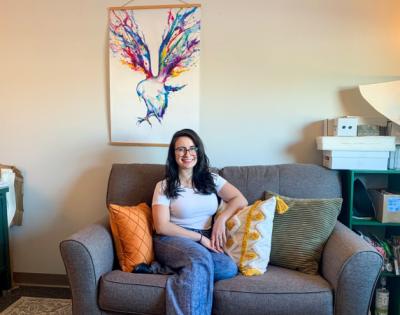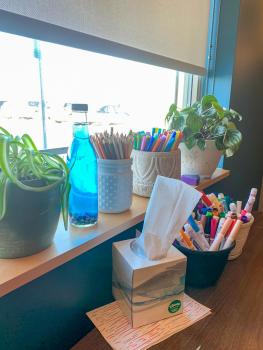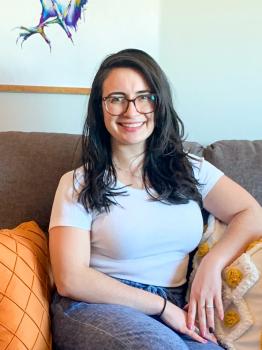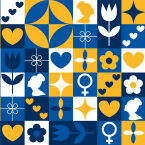
For Danielle Klapper, a blank canvas and plastic cups filled with thin paint could be the makings of an art therapy session for a client who struggles to let go of control. Danielle would give a directive – pour the paint on the canvas – and then help the client process what they experienced. What was it like to not have control as the paint flowed around the canvas? What could be controlled in this situation?
Danielle is an art therapist with The Village Family Service Center. Her office at The Village’s Moorhead, Minn., location features the traditional couch and chairs of any counseling office, as well as shelves lined with fine art and craft supplies.
Art is a brain-based activity, Danielle says. Coupling it with talk therapy ties both sides of the brain together, connects the cognitive and emotional, and taps into the nervous system through motor and sensory means.
“I enjoy that you don’t always have to talk to process something,” Danielle says. “You can make connections that you don’t always make when not integrating the two sides of the brain.”
There’s no such thing as a typical session, she says, and not everyone who walks through her door will do art therapy. But integrating art directives into her therapy sessions can help clients open up and begin to process difficult emotions. Art therapy also allows Danielle to gather a lot of information quickly. For example, by asking a child to draw all the members of her family doing an activity, she gets to know more about them and their situation.
Danielle studied art education and psychology as an undergraduate student in upstate New York. “Through student teaching, I realized I really gravitated toward the kids other people labeled as ‘bad kids,’ but really they just needed someone to listen, because they’d been through so much in their lives,” she says.
That led her to pursue a master’s degree in Creative Arts Therapy at Nazareth College in Rochester, New York.

Art therapy often is not what people expect. “Everyone always thinks you have to be good at art or creative,” she says. “It’s about the process and what you experience during it, not what you’re actually doing or making.”
Danielle might suggest clients draw a “monster” in their life. She guides them to think through its size, shape, color, and texture. This allows a fear or concern to be externalized and fleshed out. Sometimes they turn the monsters into puppets.
The art directives Danielle chooses depend on the client’s needs. She weighs the nature of the material – Is it fluid or rigid? Symbolic or abstract? – and what it evokes. She uses both traditional art mediums, like paints or pastels, and craftier items, like pipe cleaners, coffee filters, popsicle sticks, and paper mache.
Clients might make a collage, tearing photos out of the discarded books Danielle collects, or they could create a deck of cards, each one featuring a different coping skill.

Danielle distinguishes between the deep, integrated process of art therapy, always done under the guidance of a trained therapist, and “art as therapy.” People can find a lot of therapeutic value in doing art on their own, she says, but they wouldn’t have the support of a therapist to help them process their thoughts and emotions. Examples of art as therapy could include scribbling on a sheet of paper to release anger or using coloring books to ground oneself.
Everyone can benefit from art therapy, Danielle says, especially those who are open to the idea and who wouldn’t automatically be drawn to art. For example, kids are naturally exploratory, artistic, and playful, while that might not be the default for teens and adults. She notes it’s not as effective in crisis situations, where a client’s safety is the primary concern.
“There needs to be a degree of openness and understanding,” she says. “Art directives can be used in so many different ways. … People are in awe of the possibilities.”
To schedule an appointment with Danielle, call 701-451-4811 or request an appointment online.








